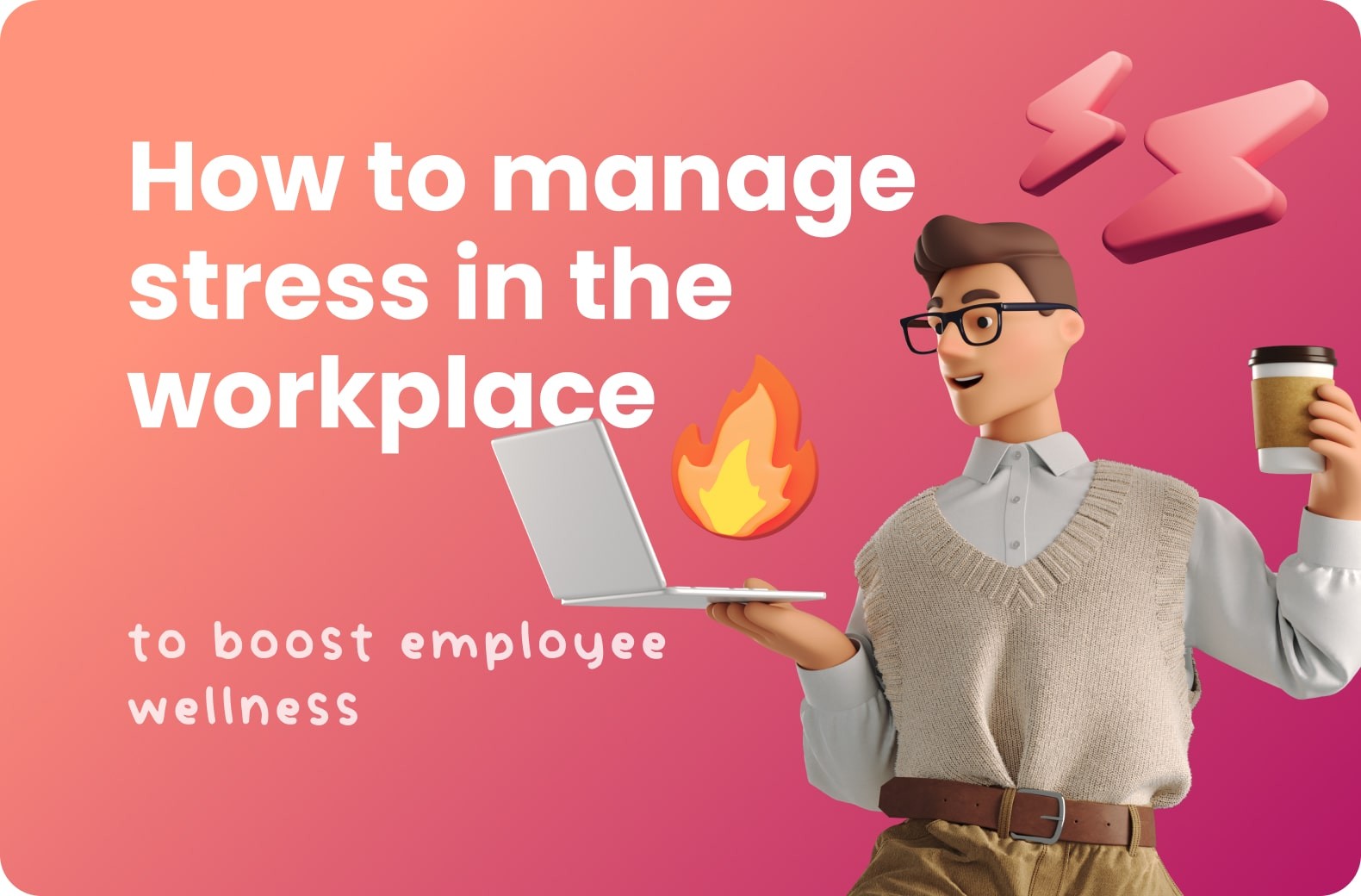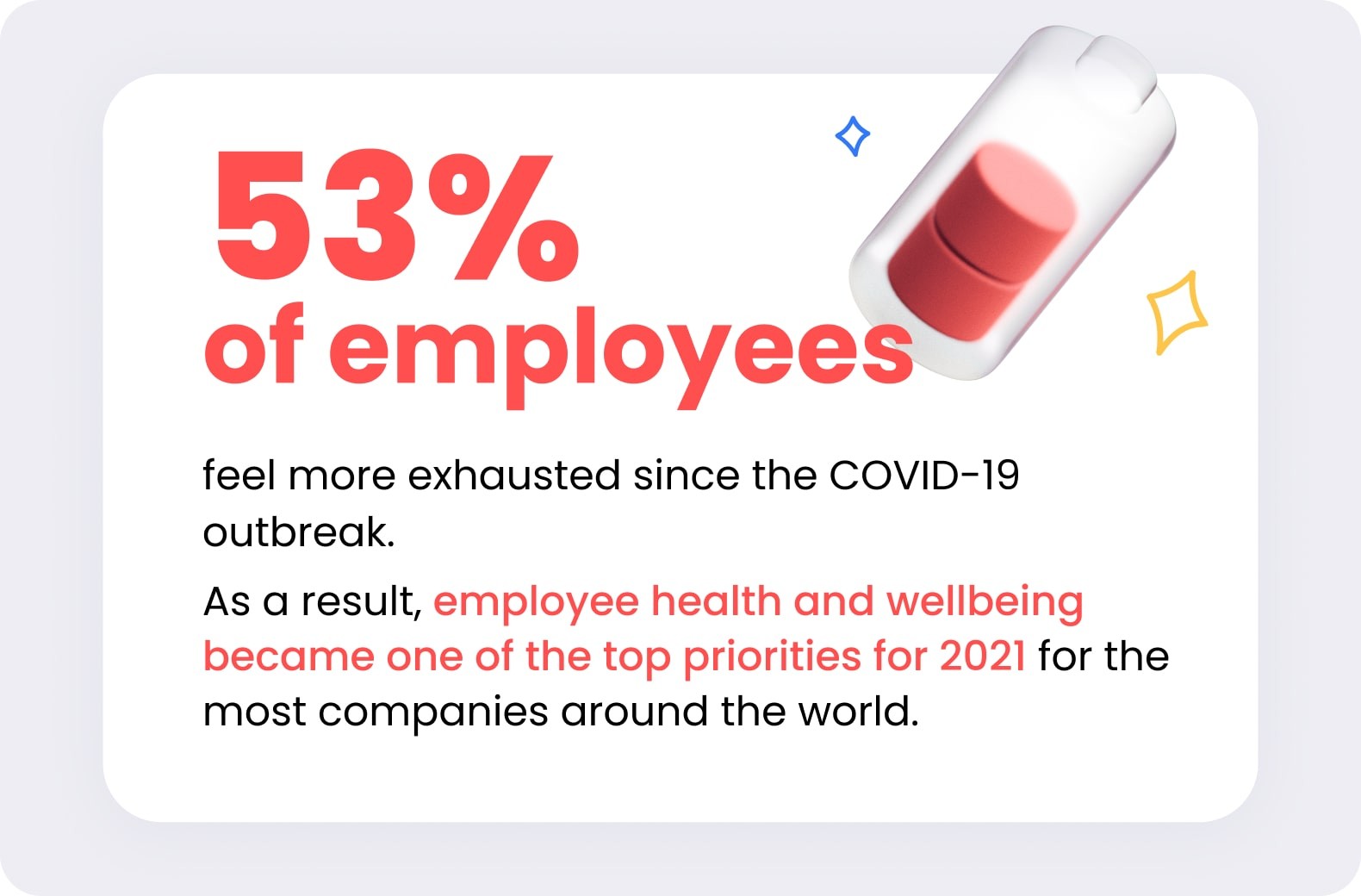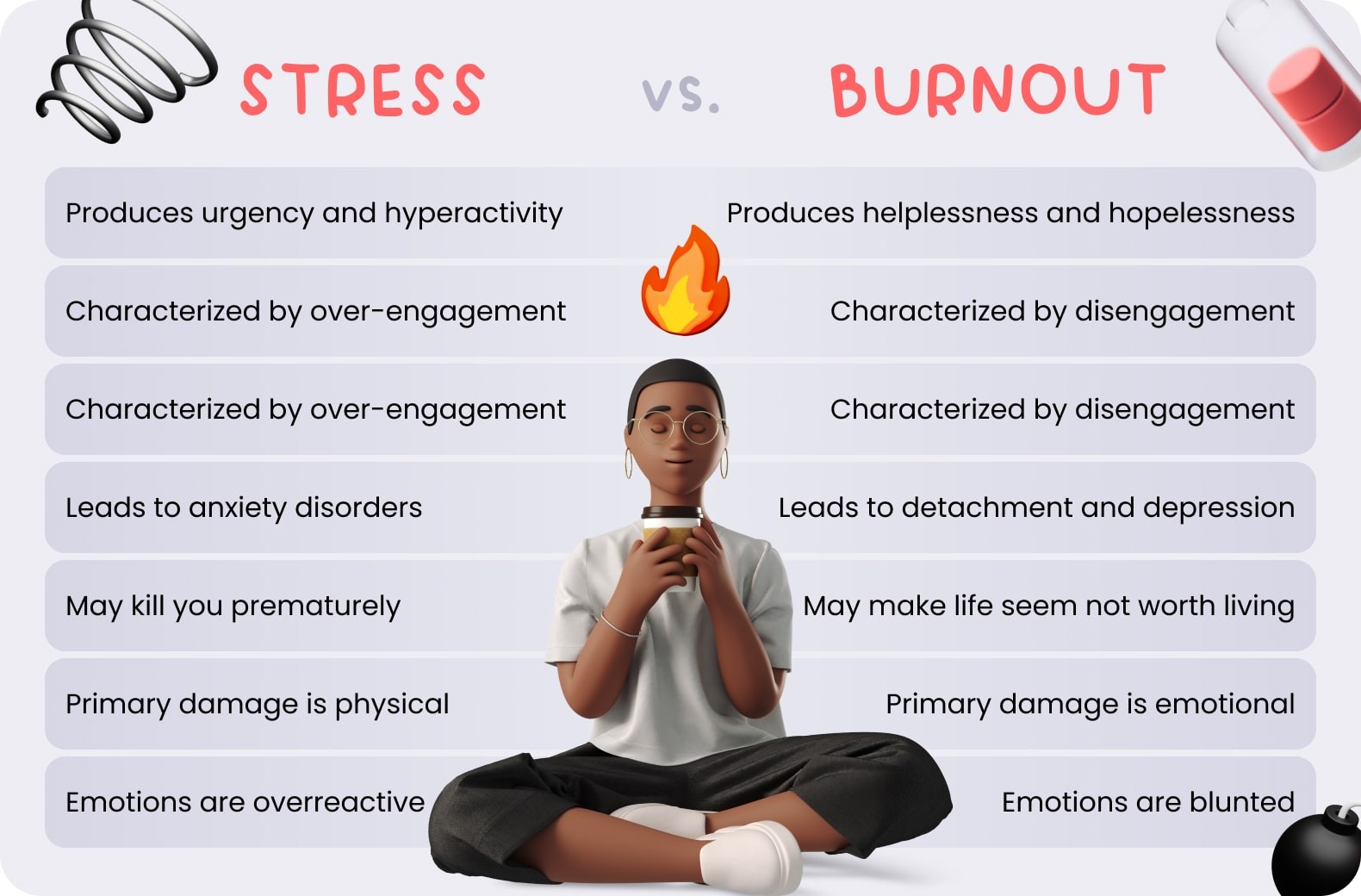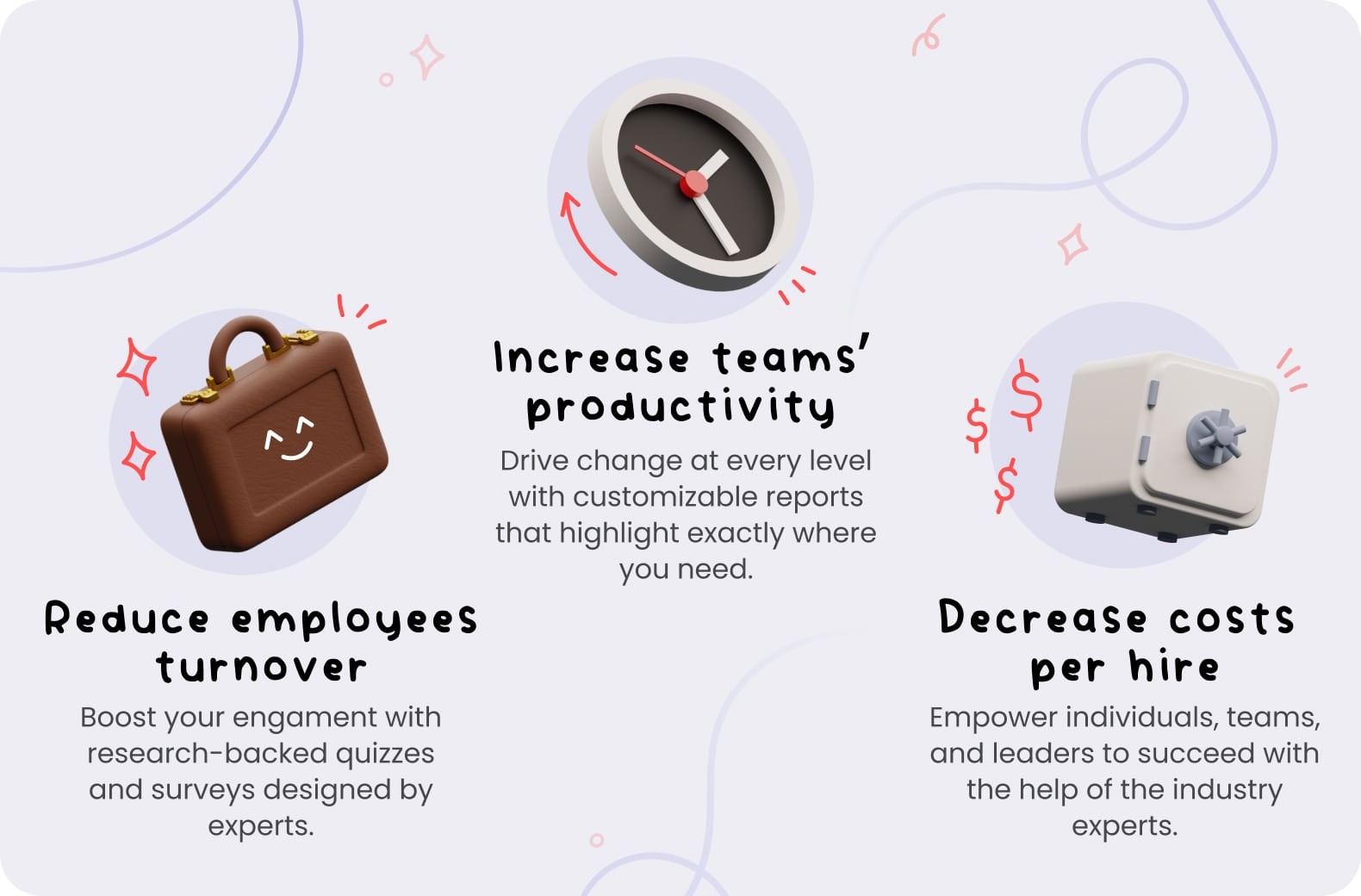This article will cover the following topics:
- The signs of stress
- Three big causes of work stress
- How to recognize burnout
- How much stress is normal?
- How to assess stress in your workforce
- Ways to relieve stress today
- Embracing employee feedback
- Tips to maintain an engaged workforce
- Using Screver for employee insights
What are the signs of stress at work?
When people start to feel stressed out at work, it can manifest in all kinds of mental and physical symptoms. What shows up as stress in one employee might be entirely different in another. Some people will display their frustrations, while others might bottle them up. If you want to help your employees with stress management and create the appropriate stress reliever solutions, it helps to understand it from the ground up.
What is work stress?
According to the CDC:
Job stress is defined as the harmful physical and emotional responses that occur when the requirements of the job do not match the capabilities, resources, or needs of the worker. Job stress can lead to poor mental health and even physical injury.
Symptoms of work-related stress
Unfortunately, a change in stress hormones can affect the body in several ways, resulting in a range of physical and mental health symptoms. It’s important to take steps to reduce stress as soon as you become aware of any of the following symptoms.
Physical symptoms
- Fatigue
- Muscle tension
- Increased blood pressure
- Heart palpitations
Psychological symptoms
- Anxiety
- Negative outlook
Behavioral symptoms
- Mood swings
- Irritability
- Decreased performance
From a management perspective, the perceived stress of your employees is going to be different from their actual experiences. You might notice a slight drop in someone’s performance that is more like a small blip when in reality, that person’s stress level is really high.
It’s important to get feedback from your employees whenever possible because those who are hard workers are usually great at hiding it, and it’s your responsibility to do what you can to support them.
Benefits of managing stress
Stress affects everyone differently, but the benefits can help everyone the same!
- Improved mental health
- Lowered blood pressure
- Lower risk of chronic stress
- Improved stress response-learning to cope with stress is far more healthier than reacting at the moment
- Improved sympathetic nervous system
- Everyday life is easier to manage
- Regular exercise is just the beginning of improved health
What are the 3 causes of work stress?
While there are many different things that can increase your stress levels at work, most of them can be broken down into the following three groups: relationships, workplace culture, and job demands.
Management and work relationships
When it comes to your work, the relationships you have with colleagues will have a direct impact on how you feel day to day.
Bad relationships with coworkers
You don’t need to get along with everybody. It’s natural that you might not see eye to eye with everyone. However, you don’t want to have negative energy floating around the workplace. If there’s a stressful meeting coming up, the last thing people should be worried about are their personal politics. Keeping everyone on task and on decent terms will help avoid stressful situations, especially when you really don’t have the time for it.
Job insecurity
If employees don’t have a direct line of contact or a positive relationship with management, it can cause a lot of insecurity. One of the biggest drivers of employee retention is job security, so you want to be certain that your employees feel valued and secure in their position.
Job discrimination or harassment
Sometimes stress can be tracked down to an employee experiencing discrimination or harassment. These things can be difficult for people to talk about in general, so try to be sensitive and provide a safe space for your team to confide in you.
Workplace culture
Over-supervision
It’s great to provide social support to your employees, but try to be aware of when it might be too much. Employees perform better when they feel like you trust them.
Inadequate environment
Employees are more likely to experience stress if their surrounding environment isn’t supportive of their workday. You should always make sure everyone has the supplies they need to carry out their everyday tasks.
Little room for growth
If your employees have even one other family member in their home to support, staying in their role long-term just won’t cut it. Part of understanding the needs of a growing workforce includes supporting the growth of your existing employees.
- Job demands
- Long hours
If there isn’t equal or above compensation, long working hours are a huge source of stress for any type of employee. It’s one thing if a person is compensated fairly or above expectations, but you can’t expect anyone to do more than what they are paid for or agreed to do.
Demanding deadlines
Deadlines are a huge source of stress, especially if your work environment typically has one after another. Try to come up with time management tips or use an app to help your team stay on task.
Changing duties
When you hire someone, you need to be clear about your expectations. If someone is suddenly being asked to do something outside of their job description, not only will it cause stress, but it decreases trust between you and your employee.
What does burnout feel like?
Even if you’re lucky enough to be unfamiliar with it, there are several ways to recognize the signs of burnout. To put it simply, burnout is a state you can reach after a period of prolonged stress. It is typically recognized by extreme emotional, physical, and mental exhaustion. In other words, it’s when you finally reach that breaking point, where you simply cannot perform any longer. It takes much longer to recover from burnout than it does to just manage stress.
The difference between stress and burnout
It’s important to recognize the difference between stress and burnout so you can make sure you’re getting the support you need for yourself or your team. Below you’ll find a helpful infographic to help illustrate the more significant differences between the two.
Stress and burnout are both capable of wreaking havoc on your mental and emotional health, but they show up differently.
Is it normal to stress about work?
While having some level of stress shows you care, you don’t want to experience anything that might be a detriment to your mental or physical health. Understanding work/life balance and upholding healthy boundaries is a good way to ensure that you won’t be a risk for burnout.
Think about how you feel day-to-day. It’s normal to feel stressed out around deadlines, new launches, and other activities. However, if you’re feeling stressed out at times that you should really feel relieved, it might be time to consider some kind of stress management.
How to check on employee stress in the workplace?
At the end of the day, the only way to gauge how people feel at work is to request individualized feedback. Make sure you provide a safe and anonymous way for employees to share their ideas a grievances. You can even offer some kind of reward for participating.
Gather all of your most valuable HR pain points, and choose your favorite feedback platform. Screver has some of the best integrations out there for businesses to get valuable insights and detailed analytics to drive business solutions.
Ways you can relieve stress right now
If you want to keep productivity high, try introducing different tools to deal with stress at work. The mental and physical health of your employees should be a major priority, up there with boosting profits and improving business practices.
Identify the stress
There’s no way to really rid yourself of stress if you don’t understand where it’s coming from. You might be able to alleviate it for a moment, but it’ll always come back if you don’t figure out the root of the issue.
A great way to keep track of your stress is by using a stress journal. You can keep it to yourself and tuck it away somewhere safe when it isn’t in use. This is especially great to recommend to anyone who might have difficulting paying for or making time for counseling. Journaling regularly can bring a lot of things to light and help people work through mental challenges they weren’t previously aware of.
Keep yourself moving
Sometimes it’s hard not to get bogged down by negative thoughts, especially if there are precarious things happening in your personal life. However, it’s important to show employees that it’s possible to keep a positive attitude even if things aren’t perfect.
Stay connected with others
It’s no secret that laughter is a surefire way to reduce stress. When we feel connected with others, we feel less alone in the world, and that alone is a great stress reliever. Especially when it comes to work, when you feel connected with your colleagues, you’ll immediately find it easier to cope with the stress that might be related to your work.
Make time to relax and unwind (after-work ritual)
Try to combat stress with your very own stress relief routine after work. Physical movement is said to be a great way to reduce your stress hormone, so whether you do after-dinner yoga or walk your dog, having a moment of reprieve to look forward to is the goal.
Work on time management skills
When you feel balanced, you’re much less likely to become overwhelmed by a thing or two not going as planned. In the workplace, it’s hard to predict exactly how the day is going to pan out, so you need to make sure you and your employees are always working on time management skills. Remember, it’s much more productive to focus on the things you can control.
Try to keep a relatively healthy lifestyle
Behaviors to embrace
- Balanced diet-A healthy diet is great for a lot of things, but your blood sugar is directly correlated
with the body’s response to stress. - Good night’s sleep-your parasympathetic nervous system needs time to recover and improves with better
sleep quality. - Physical exercise-regular exercise is important no matter how good of shape you might be in. You can
improve blood flow, reduce muscle tension, and practice deep breathing without even realizing it.
Things to avoid
- Don’t drink alcohol-drinking alcohol might feel like it helps reduce stress levels in the moment, but it also hinders your body’s natural recovery process. Nervous system health is paramount when it comes to stress,
- Impulsive eating behaviors-for some people, eating is often tied into their stress response.
- Stressful situations-never spend more time than you need to in any situation that causes you more stress
than good.
Learn coping skills to reduce stress in the present moment
Breathing techniques: the moment you start to feel the anxiety kick in, take a few deep breaths.
If at any point you or someone else is experiencing overwhelming stress, there’s nothing wrong with seeking professional help. Even if it’s just for some quick feedback, it’s reassuring to confirm if you might want to seek out medical advice diagnosis, or treatment.
Embrace employee feedback. Don’t shy away from it
When it comes to understanding employees, there are a lot of barriers that managers face when trying out problem-solving techniques. Some employees might feel uncomfortable or unwilling to share feedback for different reasons. It’s natural that some might be afraid of anonymity, while others don’t understand the value of providing feedback.
Without the proper measures in place, managers remain unaware of potential problems in the workplace and are ill-equipped to create and enforce solutions.
The bottom like is, that if you want to lower stress in the workplace, you need to seek out valuable feedback. Managers might be nervous that sending out a pulse survey could create more anxiety and stress, but any feedback is better than no feedback.
If you’re nervous about getting negative feedback, that’s just something that you need to overcome. It’s like the age-old adage of ripping the band-aid off. It might not be pleasant, but once you just confront it, you’ll be able to heal from it.
As long as you are willing to help your employees manage stress in a healthy way, you shouldn’t be worried about feedback. It only stands to improve over time, and soon enough you’ll be impatient to get those results.
Tips to maintain an engaged remote workforce
- If you’re a leader, you need to lead by example, so take stock of your current workplace and routine and see if there is anything you could improve upon.
- If you approach your employees with a story about how you took measures into your own hands for your own productivity, it might even help forge new connections.
- Employees generally appreciate when they are spoken to as an equal by their supervisors as if everyone might be going through something similar. It’s a human instinct to want to relate and belong, so remember that when you approach sensitive topics like work performance and stress.
- If you have a lot of remote employees, chances are you’re familiar with the challenges of keeping your teams engaged.
Remote work has its benefits, but if you don’t stay on top of employee engagement, you’ll have a lot more work down the line.
Focus on mental health and employee wellbeing
When you put your employees’ well-being first, you can’t go wrong.
- Ensure a safe work environment
- Promote physical activity
- Share relaxation techniques and wellness tips
Stay consistent with company culture-lead by example
Sometimes the best way to instill values in your team is by exhibiting them yourself. If you want to create a strong company culture that respects stress management and overall well-being.
Give employees space to form their own sense of self within the organization
Provide ample training to everyone in the organization. Make sure each employee is set up properly to complete their work daily.
Set clear boundaries to promote a solid work/life balance
It’s only natural that an employee experiences stress from time to time. Feeling stressed to a slight degree shows that someone cares about the task at hand. However, it’s down to managers to draw the line to protect the mental health of their workforce.
Use Screver to get valuable employee insights
With an extensive library of survey templates to choose from, Screver has everything you need to get on the same page as your employees. Our platform helps companies keep track of employee feedback and provides the insights necessary to act on it efficiently.
Feedback is our love language, and we aim to provide the best in analytics and insights when it comes to your employee satisfaction. Using unique and customizable designs, you can start to build a bridge to a stronger relationship between you and your employees.








